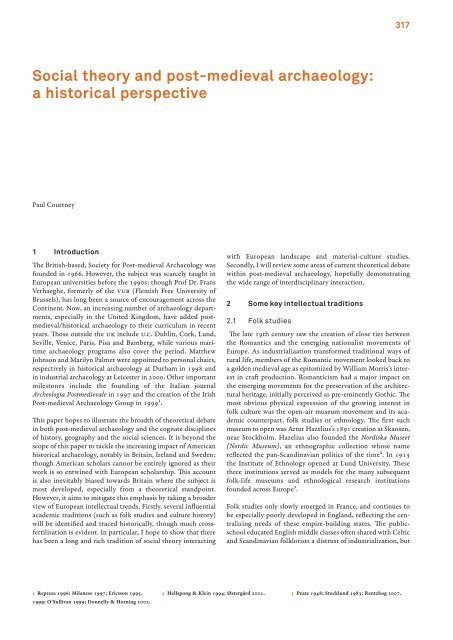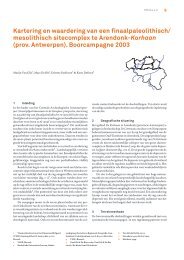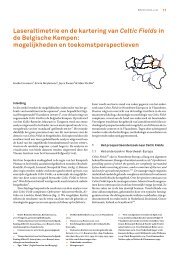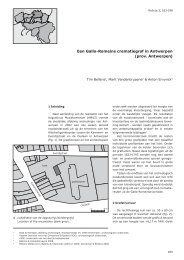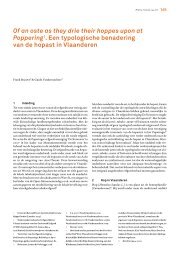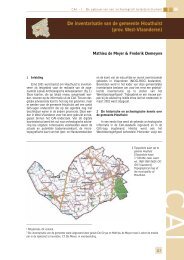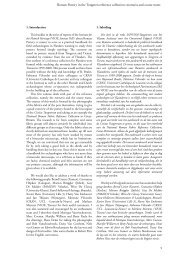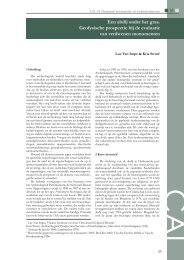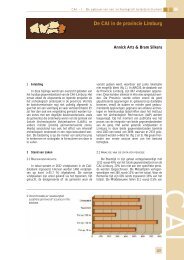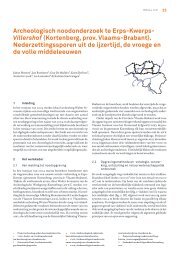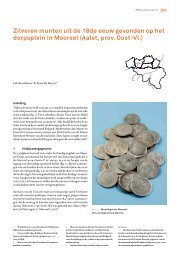Exchanging Medieval Material Culture Studies on archaeology and ...
Exchanging Medieval Material Culture Studies on archaeology and ...
Exchanging Medieval Material Culture Studies on archaeology and ...
You also want an ePaper? Increase the reach of your titles
YUMPU automatically turns print PDFs into web optimized ePapers that Google loves.
Social theory <strong>and</strong> post-medieval <strong>archaeology</strong>:<br />
a historical perspective<br />
Paul Courtney<br />
1 Introducti<strong>on</strong><br />
Th e British-based, Society for Post-medieval Archaeology was<br />
founded in 1966. However, the subject was scarcely taught in<br />
European universities before the 1990s; though Prof Dr. Frans<br />
Verhaeghe, formerly of the vub (Flemish Free University of<br />
Brussels), has l<strong>on</strong>g been a source of encouragement across the<br />
C<strong>on</strong>tinent. Now, an increasing number of <strong>archaeology</strong> departments,<br />
especially in the United Kingdom, have added postmedieval/historical<br />
<strong>archaeology</strong> to their curriculum in recent<br />
years. Th ose outside the uk include u.c. Dublin, Cork, Lund,<br />
Seville, Venice, Paris, Pisa <strong>and</strong> Bamberg, while various maritime<br />
<strong>archaeology</strong> programs also cover the period. Matthew<br />
Johns<strong>on</strong> <strong>and</strong> Marilyn Palmer were appointed to pers<strong>on</strong>al chairs,<br />
respectively in historical <strong>archaeology</strong> at Durham in 1998 <strong>and</strong><br />
in industrial <strong>archaeology</strong> at Leicester in 2000. Other important<br />
milest<strong>on</strong>es include the founding of the Italian journal<br />
Archeologia Postmedievale in 1997 <strong>and</strong> the creati<strong>on</strong> of the Irish<br />
Post-medieval Archaeology Group in 19991.<br />
Th is paper hopes to illustrate the breadth of theoretical debate<br />
in both post-medieval <strong>archaeology</strong> <strong>and</strong> the cognate disciplines<br />
of history, geography <strong>and</strong> the social sciences. It is bey<strong>on</strong>d the<br />
scope of this paper to tackle the increasing impact of American<br />
historical <strong>archaeology</strong>, notably in Britain, Irel<strong>and</strong> <strong>and</strong> Sweden;<br />
though American scholars cannot be entirely ignored as their<br />
work is so entwined with European scholarship. Th is account<br />
is also inevitably biased towards Britain where the subject is<br />
most developed, especially from a theoretical st<strong>and</strong>point.<br />
However, it aims to mitigate this emphasis by taking a broader<br />
view of European intellectual trends. Firstly, several infl uential<br />
academic traditi<strong>on</strong>s (such as folk studies <strong>and</strong> culture history)<br />
will be identifi ed <strong>and</strong> traced historically, though much crossfertilisati<strong>on</strong><br />
is evident. In particular, I hope to show that there<br />
has been a l<strong>on</strong>g <strong>and</strong> rich traditi<strong>on</strong> of social theory interacting<br />
1 Represa 1996; Milanese 1997; Ericss<strong>on</strong> 1995,<br />
1999; O’Sullivan 1999; D<strong>on</strong>nelly & Horning 2002.<br />
2 Hellsp<strong>on</strong>g & Klein 1994; Østergård 2002. 3 Peate 1948; Stocklund 1983; Rentzhog 2007.<br />
317<br />
with European l<strong>and</strong>scape <strong>and</strong> material-culture studies.<br />
Sec<strong>on</strong>dly, I will review some areas of current theoretical debate<br />
within post-medieval <strong>archaeology</strong>, hopefully dem<strong>on</strong>strating<br />
the wide range of interdisciplinary interacti<strong>on</strong>.<br />
2 Some key intellectual traditi<strong>on</strong>s<br />
2.1 Folk studies<br />
Th e late 19th century saw the creati<strong>on</strong> of close ties between<br />
the Romantics <strong>and</strong> the emerging nati<strong>on</strong>alist movements of<br />
Europe. As industrialiaati<strong>on</strong> transformed traditi<strong>on</strong>al ways of<br />
rural life, members of the Romantic movement looked back to<br />
a golden medieval age as epitomized by William Morris’s interest<br />
in craft producti<strong>on</strong>. Romanticism had a major impact <strong>on</strong><br />
the emerging movements for the preservati<strong>on</strong> of the architectural<br />
heritage, initially perceived as pre-eminently Gothic. Th e<br />
most obvious physical expressi<strong>on</strong> of the growing interest in<br />
folk culture was the open-air museum movement <strong>and</strong> its academic<br />
counterpart, folk studies or ethnology. Th e fi rst such<br />
museum to open was Artur Hazelius’s 1891 creati<strong>on</strong> at Skansen,<br />
near Stockholm. Hazelius also founded the Nordiska Museet<br />
(Nordic Museum), an ethnographic collecti<strong>on</strong> whose name<br />
refl ected the pan-Sc<strong>and</strong>inavian politics of the time2. In 1913<br />
the Institute of Ethnology opened at Lund University. Th ese<br />
three instituti<strong>on</strong>s served as models for the many subsequent<br />
folk-life museums <strong>and</strong> ethnological research instituti<strong>on</strong>s<br />
founded across Europe3.<br />
Folk studies <strong>on</strong>ly slowly emerged in France, <strong>and</strong> c<strong>on</strong>tinues to<br />
be especially poorly developed in Engl<strong>and</strong>, refl ecting the centralizing<br />
needs of these empire-building states. Th e publicschool<br />
educated English middle classes oft en shared with Celtic<br />
<strong>and</strong> Sc<strong>and</strong>inavian folklorists a distrust of industrializati<strong>on</strong>, but


